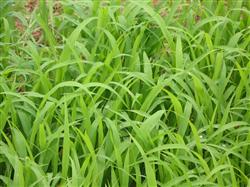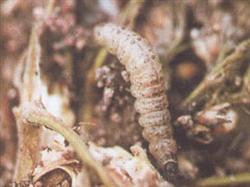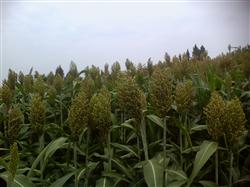Which diseases and insect pests are mainly controlled by planting sorghum?

Which diseases and insect pests are mainly controlled by planting sorghum? Please give guidance to plant sorghum to control the following diseases and insect pests: first, sorghum smut is a common disease in sorghum in Liaoning, including head smut, loose smut and head smut. Symptom identification: the symptom of head smut is obvious after heading, the diseased plant is generally short, the lower expanded bracts of the diseased ear before heading are tight, there are white sticks in it, and a large amount of black powder is scattered after heading. Loose smut is generally damaged by the whole ear, but the spike shape is normal, but the grain becomes an oblong small ash bag, which breaks after maturity and spreads out the black powder inside. The grains of the whole ear usually turn into egg-shaped gray bags, the outer membrane is hard, does not break or only slightly split at the top, and the interior is full of black powder. Occurrence characteristics: sorghum head smut is transmitted through seeds and soil, which is mainly transmitted by soil. Chlamydospores survive in the soil for about 3 years and infect sorghum buds when the white tip of sorghum seeds is exposed to the bud length of 1.5 cm. Sorghum scattered black ear and hard black ear pathogen mainly attached to the seed surface with thick chlamydospores. After sowing the diseased seeds, the pathogen and the seeds germinated at the same time and invaded the host tissue. After the invasion of the pathogen, the hyphae spread to the seedling growth cone, then elongated with the upward growth of the plant growth point, and finally formed teliospores in the ear. Prevention and control methods: (1) select disease-resistant varieties according to local conditions. (2) Chemical treatment of seeds is the most important, simplest and most effective powder method to control sorghum smut. ① 2% Likexiu mixed seeds with 0.1% of seed weight (0.2% of seed weight with rice soup) or 50% of seed weight with 0.5% of seed weight. ② uses 20% vermicellin EC 100ml, add a small amount of water, mix seeds 100kg, try to mix the concrete evenly, spread out and dry before sowing. ③ use 20% verapamil EC (or wettable powder) 0.5kg, add 3kg water, mix seeds 40kg, sow seeds for 4 hours, then sow seeds after drying. (3) the practice of crop rotation for more than 3 years to reduce the amount of bacteria in the soil is an important measure to control smut. (4) advocating late sowing at the right time and striving for early emergence and whole seedling emergence. Cut down the diseased plant in time, and before the ash bag breaks, cut down the diseased plant and pull it out of the ground to destroy it. Second, sorghum aphids are mainly damaged by sorghum aphids, followed by wheat bifurcated aphids, wheat long tube aphids, corn aphids, grain aphids, Yu four aphids, collectively known as sorghum aphids. Damage characteristics: the sorghum aphid parasitized on the leaf back of the host crop sucked nutrients, and at the initial stage, it was mostly damaged in the lower leaves, gradually spread to the upper leaves of the plant, and secreted a large amount of honeydew, dripping on the lower leaves and stems, shining, affecting plant photosynthesis and normal growth, resulting in red leaves, "bald neck" and "blind tip" spikes with few grains, affecting the yield and quality of sorghum. Occurrence characteristics: sorghum aphid has short generation and rapid reproduction. The eggs overwintered on the grass, and when the sorghum emerged in June, it moved into the sorghum field to propagate, and the spot occurred at the seedling stage. During this period, if the average temperature is more than 22 ℃ and the rainfall is less than 25 mm (high temperature and humidity), sorghum aphids may occur greatly, on the contrary, if there is more rainfall and low temperature during this period, it is not conducive to the occurrence of aphids. Control methods: (1) early elimination of central aphid plants (that is, Wozi honey), the method can be gently cut off the bottom leaves of aphids, taken out of the field for destruction. 1500 times dimethoate powder or 40% dimethoate EC was used for spot application. (2) 50 grams of 40% dimethoate EC per mu, and the same amount of water was evenly mixed into 10Mel 13 kg fine sandy soil to prepare dimethoate poisonous soil and sprinkle it on sorghum plants before heading. (3) 5% methyl mixed with phosphorus granule fumigation, 200 grams of phosphorus mixed with methylene per mu, 10 kg of sandy soil, sprinkled into ridges, 1 ridge every 12 ridges, with special effect. Click to get more sorghum planting technology click to get more grain planting technology
- Prev

How to control sorghum pests?
How to control sorghum pests? Please introduce that sorghum pests are mainly aphids, Spodoptera litura, borers and beetles. Aphids and beetles occur at seedling stage, and Spodoptera litura and borer damage occur at heading stage and wax ripening stage, which can be controlled by pesticides such as chlorpyrifos, BT, green crystal and so on. Sorghum against trichlorfon, dichlorvos, fenitrothion.
- Next

How to apply fertilizer scientifically when planting sorghum
How to fertilize sorghum scientifically? Please give guidance to sorghum with wide adaptability to soil and strong fertilizer absorption. If you plant sorghum on sandy loam with rich organic matter and high fertility, it is easy to get high yield. In lean dry land, lack of phosphorus and low potassium, you must apply more fertilizer in order to get a good harvest. Sorghum seedling plant is small, the amount of fertilizer needed is not.
Related
- The first cup of black tea in spring, the flavor and history of tea gardens in Kenya, Africa
- The computer can not only choose potatoes, but also grow tea rice. AI will grow winter oolong tea champion.
- It is not only the inflated tea bitten by insects, but also engraved with the four seasons tea in Beipu.
- The Oriental Beauty Tea Festival in Zhuxian County takes the stage at the weekend to experience the plus-size feast of oil tea.
- & quot; Oriental Beauty Tea & Exploration of Emei in Hsinchu, the hometown of quot;
- The new variety of strawberry "Tainong 1" dessert is the first choice with mellow aroma. Crimson gorgeous
- History of Tea in Taiwan: from Wild Inner Mountain to Export Tea Garden
- Two types of Taiwan Oriental Beauty Black Tea won the British three-Star Award for Childhood Tea Xiang Zhang Jiaqi changed from pilot to champion tea maker.
- Banana species and varieties: the planting history of Taiwan Xianren banana and dwarf banana is long, is banana disease resistant?
- Coffee planting Technology: Qianjie Coffee from Seedling to harvesting

